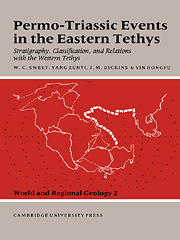 Permo-Triassic Events in the Eastern Tethys
Permo-Triassic Events in the Eastern Tethys Published online by Cambridge University Press: 12 October 2009
Introduction
The purpose of this report is to illustrate the characters of the Permo-Triassic boundary in the Southern Alps. This was also the object of an international meeting in July, 1986, which was arranged cooperatively by the Geological Society of Italy and the leadership of IGCP Project 203. Most of the opinions expressed and conclusions reached at that meeting have been published (Cassinis, 1988). We have undertaken a further revision, however, in view of later reflections and subsequent data.
In the following report, the senior author considers the primarily marine deposits between the Adige Valley and Carnia, and compares them with deposits in adjacent Yugoslavia, whereas the junior author reviews Permian continental sequences of the South-Alpine region, mainly west of the sector discussed by Broglio Loriga, and considers their contact with overlying units.
The marine Upper Permian and the Permo-Triassic boundary
Eastern Southern Alps
The Middle(?) and Upper Permian of the Dolomites and Carnia consists of two lithostratigraphic units, the Val Gardena Sandstone and the Bellerophon Formation, which taken together may be regarded as a composite transgressive sequence. The Val Gardena Sandstone consists mainly of terrigenous clastics, in part typical red beds, which were deposited in a semi-arid setting. The Bellerophon Formation is composed mostly of chemical sediments (carbonates and sulphates) and its facies associations suggest a wide spectrum of depositional environments, ranging from a coastal sabkha to shallow-shelf settings. The Bellerophon Formation wedges out westward and disappears west of the Adige Valley by gradation into continental deposits (Figs 8.1, 8.2).
To save this book to your Kindle, first ensure [email protected] is added to your Approved Personal Document E-mail List under your Personal Document Settings on the Manage Your Content and Devices page of your Amazon account. Then enter the ‘name’ part of your Kindle email address below. Find out more about saving to your Kindle.
Note you can select to save to either the @free.kindle.com or @kindle.com variations. ‘@free.kindle.com’ emails are free but can only be saved to your device when it is connected to wi-fi. ‘@kindle.com’ emails can be delivered even when you are not connected to wi-fi, but note that service fees apply.
Find out more about the Kindle Personal Document Service.
To save content items to your account, please confirm that you agree to abide by our usage policies. If this is the first time you use this feature, you will be asked to authorise Cambridge Core to connect with your account. Find out more about saving content to Dropbox.
To save content items to your account, please confirm that you agree to abide by our usage policies. If this is the first time you use this feature, you will be asked to authorise Cambridge Core to connect with your account. Find out more about saving content to Google Drive.